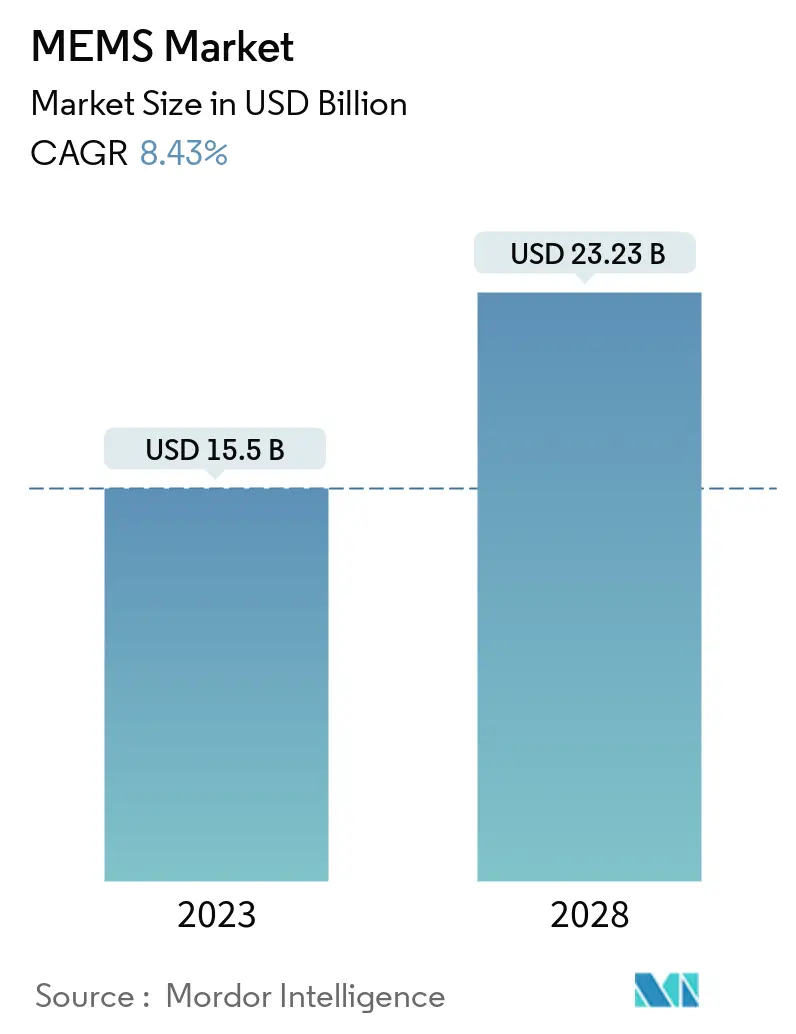Market Size of MEMS Industry

| Study Period | 2018 - 2028 |
| Market Size (2023) | USD 15.5 Billion |
| Market Size (2028) | USD 23.23 Billion |
| CAGR (2023 - 2028) | 8.43 % |
| Fastest Growing Market | Asia Pacific |
| Largest Market | Asia Pacific |
Major Players
*Disclaimer: Major Players sorted in no particular order |
Need a report that reflects how COVID-19 has impacted this market and its growth?
Micro-Electro-Mechanical System Market Analysis
The MEMS Market size is estimated at USD 15.50 billion in 2023, and is expected to reach USD 23.23 billion by 2028, growing at a CAGR of 8.43% during the forecast period (2023-2028).
The MEMS sector is witnessing rapid growth due to the increasing demand for MEMS in multiple applications, from automotive to consumer electronics.
- The market numbers stated in the study indicate MEMS in terms of the revenue accrued by products offered in the market by the vendors, sold across different geographical regions, based on their type and applications.
- With emerging applications and business models, IoT has an enormous requirement for tiny and low-cost sensors that can monitor all aspects of production. These sensors will likely communicate the information to other nodes in the factory network. They are expected to operate reliably in harsh conditions of the electrical and mechanical environment.
- MEMS plays a key role in the field of automation. The MEMS technology offers sensitivity, reliability, scalability, and a cost-effective design. This provides more opportunities in the field of automation. The industry relies on these technologies for higher throughput and production rates in less time. MEMS accelerometers and gyroscopes are ideal for use in various industrial automation applications. With their minute size, high reliability, and low power credentials, MEMS sensors can play a vital role in virtually any piece of industrial automation machinery.
- MEMS devices vary from a relatively simple structure to extremely complex ones, i.e., multiple moving elements under the control of integrated microelectronics. Hence, the market faces various challenges during the complex manufacturing process.
- The usage of MEMS in the chip industry has witnessed immense growth as technology companies around the world accelerated innovation in the fight against the COVID-19 pandemic. The need for tiny devices drives advancements in electronics, ranging from thermal imaging and faster point-of-care testing to microfluidics-based polymerase chain reaction (PCR) tools and techniques to detect SARS-CoV-2.
Micro-Electro-Mechanical System Industry Segmentation
Micro-electromechanical systems (MEMS) technology is defined as the miniaturization of mechanical and electromechanical elements, such as devices and structures, manufactured and fabricated using microfabrication techniques. The types of MEMS devices vary from relatively simple structures with no moving elements to structures with multiple moving elements under the control of integrated microelectronics.
The study analyzes the market for MEMS in terms of the revenue accrued by the products offered in the market by the vendors. The study also covers the activities of major players in the market, along with their current strategies and recent developments. The impact of COVID-19 is also part of the study.
The MEMS market is segmented by type (RF MEMS, oscillators, microfluidics, environmental MEMS, optical MEMS, MEMS microphones, inertial MEMS, pressure MEMS, thermopiles, microbolometers, inkjet heads, accelerometers, and gyroscopes), by application (automotive, healthcare, industrial, consumer electronics, telecom, aerospace, and defense), and by geography (North America, Europe, Asia-Pacific, Latin America, the Middle East, and Africa). The report offers the value (in USD million) for the above segments. The market sizes and forecasts are provided in terms of value in USD million for all the segments.
| By Type | |
| RF MEMS | |
| Oscillators | |
| Microfluidics | |
| Environmental MEMS | |
| Optical MEMS | |
| MEMS Microphones | |
| Inertial MEMS | |
| Pressure MEMS | |
| Thermophiles | |
| Microbolometers | |
| Inkjet Heads | |
| Accelerometers | |
| Gyroscopes | |
| Other Types |
| By Application | |
| Automotive | |
| Healthcare | |
| Industrial | |
| Consumer Electronics | |
| Telecom | |
| Aerospace and Defense |
| By Geography | |
| North America | |
| Europe | |
| Asia-Pacific | |
| Latin America | |
| Middle East and Africa |
MEMS Market Size Summary
The Micro-Electro-Mechanical System (MEMS) market is experiencing substantial growth, driven by the rising demand for MEMS in various applications, ranging from automotive to consumer electronics. MEMS sensors have become increasingly popular due to their accuracy, reliability, and ability to facilitate the creation of smaller electronic devices. Factors such as industrial automation and the demand for miniaturized consumer devices like wearables and IoT-connected devices are fueling the market's expansion. Moreover, the growing demand for IoT devices worldwide is promoting the adoption of MEMS in these devices. However, the market faces challenges in product production and the lack of a standardized fabrication process. The application of MEMS technology in consumer electronics promises significant future advancements. MEMS are extensively used in smartphones, wearable devices, and other electronic devices due to their enhanced electrical performance at high frequencies. As the consumer electronics sector shifts its focus from conventional sensors to MEMS technology, the market is expected to grow. The proliferation of multiple chips for various sensor and actuator applications in smartphones is one of the key drivers of the MEMS market's growth. Additionally, advancements in technologies like optical image stabilization, projection displays, and fingerprint technology have significantly influenced the designs of MEMS sensors.
Explore MoreMEMS Market Size - Table of Contents
-
1. MARKET INSIGHTS
-
1.1 Market Overview
-
1.2 Industry Attractiveness - Porter's Five Forces Analysis
-
1.2.1 Bargaining Power of Suppliers
-
1.2.2 Bargaining Power of Buyers
-
1.2.3 Threat of New Entrants
-
1.2.4 Threat of Substitute Products
-
1.2.5 Intensity of Competitive Rivalry
-
-
1.3 Industry Value Chain Analysis
-
1.4 Impact of COVID-19 on the Market
-
-
2. MARKET SEGMENTATION
-
2.1 By Type
-
2.1.1 RF MEMS
-
2.1.2 Oscillators
-
2.1.3 Microfluidics
-
2.1.4 Environmental MEMS
-
2.1.5 Optical MEMS
-
2.1.6 MEMS Microphones
-
2.1.7 Inertial MEMS
-
2.1.8 Pressure MEMS
-
2.1.9 Thermophiles
-
2.1.10 Microbolometers
-
2.1.11 Inkjet Heads
-
2.1.12 Accelerometers
-
2.1.13 Gyroscopes
-
2.1.14 Other Types
-
-
2.2 By Application
-
2.2.1 Automotive
-
2.2.2 Healthcare
-
2.2.3 Industrial
-
2.2.4 Consumer Electronics
-
2.2.5 Telecom
-
2.2.6 Aerospace and Defense
-
-
2.3 By Geography
-
2.3.1 North America
-
2.3.2 Europe
-
2.3.3 Asia-Pacific
-
2.3.4 Latin America
-
2.3.5 Middle East and Africa
-
-
MEMS Market Size FAQs
How big is the MEMS Market?
The MEMS Market size is expected to reach USD 15.5 billion in 2023 and grow at a CAGR of 8.43% to reach USD 23.23 billion by 2028.
What is the current MEMS Market size?
In 2023, the MEMS Market size is expected to reach USD 15.5 billion.
